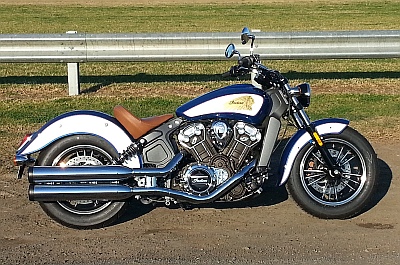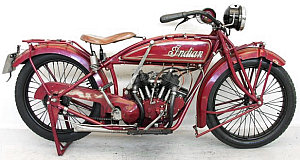ON THE WAR-PATH FOR SALES
 Open up the Indian Motorcycles brochure (yes, surprisingly in this day of everything being online, they have an actual 50-page brochure of their bikes), and on the first page, written against the backdrop of an American flag, it has “AMERICA’S FIRST MOTORCYCLE COMPANY.” Before you even get that far, on the front cover it has “1901 2017”. That’s got to be impressive, before you even look at any of their bikes!
Open up the Indian Motorcycles brochure (yes, surprisingly in this day of everything being online, they have an actual 50-page brochure of their bikes), and on the first page, written against the backdrop of an American flag, it has “AMERICA’S FIRST MOTORCYCLE COMPANY.” Before you even get that far, on the front cover it has “1901 2017”. That’s got to be impressive, before you even look at any of their bikes!
 Flip over to the next page and there is a double-page photo of some ancient machines speeding around one those bowl-type tracks that has sides that curve up from a flat centre section to walls that are vertical, with spectators lining the rim looking down at the bikes as they kick up the dust. The bikes, with their big diameter skinny wheels and curved down handlebars, and the riders with their pudding-bowl helmets, are almost horizontal as they speed around the “bowl”.
Flip over to the next page and there is a double-page photo of some ancient machines speeding around one those bowl-type tracks that has sides that curve up from a flat centre section to walls that are vertical, with spectators lining the rim looking down at the bikes as they kick up the dust. The bikes, with their big diameter skinny wheels and curved down handlebars, and the riders with their pudding-bowl helmets, are almost horizontal as they speed around the “bowl”.
 Turn the page of that colourful brochure with its historic photos, and you get another double-page spread, this time of their current range of motorcycles.
Turn the page of that colourful brochure with its historic photos, and you get another double-page spread, this time of their current range of motorcycles.
 The brochure frequently uses the word “legendary” and emphasises the heritage of the 106-year old brand. Of course that’s a bit of “thumbing-of-the-nose” at that other American brand, but it’s also telling you that a big part of what the company is, and what its products are about, is based on that heritage.
The brochure frequently uses the word “legendary” and emphasises the heritage of the 106-year old brand. Of course that’s a bit of “thumbing-of-the-nose” at that other American brand, but it’s also telling you that a big part of what the company is, and what its products are about, is based on that heritage.
 The “Scout” name, for example, goes back to 1920: and that’s a photo of the original 1920 Scout on the left.
The “Scout” name, for example, goes back to 1920: and that’s a photo of the original 1920 Scout on the left.
 However it should be pointed out that the company hasn’t been around that long; just the name.
However it should be pointed out that the company hasn’t been around that long; just the name.
 The original company barely made it through the war years (second world war, not the first), and changed ownership in 1945. That didn’t help much though, and in 1953 all production stopped. The “legendary” name-plate was then attached to a variety of bikes, most notably Royal Enfields, which were re-badged as Indians. (I'll bet you didn't know that! Neither did I!). That lasted until 1960 when the name was bought by British company AMC. That didn’t work out though, because AMC went bust just 2 years later; so the name-plate changed hands again. Fast-forward to 2011 (I won’t bore you with the history in between!) and Polaris became the new owners of the name and the bikes that carried it. So, back to that brochure again.
The original company barely made it through the war years (second world war, not the first), and changed ownership in 1945. That didn’t help much though, and in 1953 all production stopped. The “legendary” name-plate was then attached to a variety of bikes, most notably Royal Enfields, which were re-badged as Indians. (I'll bet you didn't know that! Neither did I!). That lasted until 1960 when the name was bought by British company AMC. That didn’t work out though, because AMC went bust just 2 years later; so the name-plate changed hands again. Fast-forward to 2011 (I won’t bore you with the history in between!) and Polaris became the new owners of the name and the bikes that carried it. So, back to that brochure again.
 Look at the bikes – which are parked in random style in front of a somewhat dilapidated old building that houses a workshop and a diner – and none of them look like they were designed in 2017. And you get the impression that’s the way they want it. They don’t want something that looks like it came off a 21st century version of the Starship Enterprise: they want something that looks like it might have just rolled out of a motorcycle dealership back in the 1930s, or 1950s. But with engineering that enables it to hold its head up against any of those late-comers that pretend to know what it’s all about: or that just pretend to be “legendary”.
Look at the bikes – which are parked in random style in front of a somewhat dilapidated old building that houses a workshop and a diner – and none of them look like they were designed in 2017. And you get the impression that’s the way they want it. They don’t want something that looks like it came off a 21st century version of the Starship Enterprise: they want something that looks like it might have just rolled out of a motorcycle dealership back in the 1930s, or 1950s. But with engineering that enables it to hold its head up against any of those late-comers that pretend to know what it’s all about: or that just pretend to be “legendary”.
 The range begins with the very popular Scout. Actually it now begins with a down-graded version of that, called the Scout Sixty. That has a 983cc engine, a 5-speed gearbox and retails for $17,995. (“Sixty” apparently refers to the diameter of the throttle bodies). But the brochure I got doesn’t list it, and the dealer I went to doesn’t stock them. As the owner of the dealership, former racer and local motorcycling identity Ron Sumskis, said, for not much more (it’s actually $2,000) you get the “normal” Scout with 1133cc engine, 6-speed gearbox and correspondingly better performance. So why go for the “watered-down” version?
The range begins with the very popular Scout. Actually it now begins with a down-graded version of that, called the Scout Sixty. That has a 983cc engine, a 5-speed gearbox and retails for $17,995. (“Sixty” apparently refers to the diameter of the throttle bodies). But the brochure I got doesn’t list it, and the dealer I went to doesn’t stock them. As the owner of the dealership, former racer and local motorcycling identity Ron Sumskis, said, for not much more (it’s actually $2,000) you get the “normal” Scout with 1133cc engine, 6-speed gearbox and correspondingly better performance. So why go for the “watered-down” version?
 From the Scout the range goes onwards and upwards until you get the full-dress touring version, called the Roadmaster. This has the same “Thunder Stroke” 1811cc engine that the whole range (above the Scout) gets, but with a lot of added-on technology, like keyless ignition, central locking, heated leather seat, tyre-pressure monitoring and 200-watt audio system. $40,995 for that one, please Sir. It’s a lot of money for a bike, but you get a lot of motorcycle – over 400kg of motorcycle in fact! That’s way too many kilos for this old bloke – even if the weight tends to disappear once you’re moving (which is the general consensus of those who have ridden the heavier models, like this). So I chose the Scout. At 241kg dry, it’s 100kg lighter than the next model up the range. It’s also the biggest-selling model.
From the Scout the range goes onwards and upwards until you get the full-dress touring version, called the Roadmaster. This has the same “Thunder Stroke” 1811cc engine that the whole range (above the Scout) gets, but with a lot of added-on technology, like keyless ignition, central locking, heated leather seat, tyre-pressure monitoring and 200-watt audio system. $40,995 for that one, please Sir. It’s a lot of money for a bike, but you get a lot of motorcycle – over 400kg of motorcycle in fact! That’s way too many kilos for this old bloke – even if the weight tends to disappear once you’re moving (which is the general consensus of those who have ridden the heavier models, like this). So I chose the Scout. At 241kg dry, it’s 100kg lighter than the next model up the range. It’s also the biggest-selling model.
IN THE DRIVEWAY
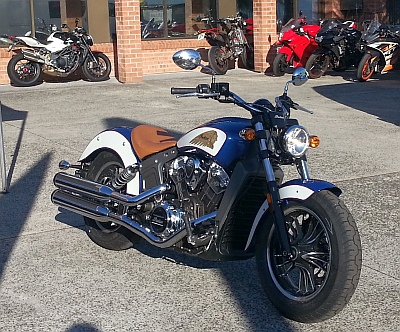
 Walk into the showroom and you can easily pick the Scout: it’s the small one. It’s at least 25cm shorter than any of its brethren, and looks smaller in all dimensions. Sitting on it, the 100kg lighter weight is immediately obvious compared to the big boys. There’s still a lot of weight there, but in typical cruiser fashion, it doesn’t feel anywhere near the weight it actually is. The low centre-of-gravity of cruisers makes them feel at least 50 or 60kg lighter than they actually are. On something like the Scout, that means you can sway it from side to side without any fear of dropping it. So, let's take a closer look at it.
Walk into the showroom and you can easily pick the Scout: it’s the small one. It’s at least 25cm shorter than any of its brethren, and looks smaller in all dimensions. Sitting on it, the 100kg lighter weight is immediately obvious compared to the big boys. There’s still a lot of weight there, but in typical cruiser fashion, it doesn’t feel anywhere near the weight it actually is. The low centre-of-gravity of cruisers makes them feel at least 50 or 60kg lighter than they actually are. On something like the Scout, that means you can sway it from side to side without any fear of dropping it. So, let's take a closer look at it.
 We’re talking about heritage (or “legendary” as the brochure keeps putting it) again. It looks, well, kinda like we’re back in the 1950s; especially around the rear mudguard and the shape of the tank anyway. But there is a definite air of modernity about it too – in particular, the steeply raked rear suspension units, and of course the big radiator and the flat-sided (not finned) engine.
We’re talking about heritage (or “legendary” as the brochure keeps putting it) again. It looks, well, kinda like we’re back in the 1950s; especially around the rear mudguard and the shape of the tank anyway. But there is a definite air of modernity about it too – in particular, the steeply raked rear suspension units, and of course the big radiator and the flat-sided (not finned) engine.
 The one thing missing, in terms of that “heritage” thing, is that iconic Indian head on the front mudguard. Come on Polaris, it’s not an Indian without that!
The one thing missing, in terms of that “heritage” thing, is that iconic Indian head on the front mudguard. Come on Polaris, it’s not an Indian without that!
 Having said all that, the bike does look really good, I reckon! I particularly like the colours on this one. There’s definite quality there too. The paintwork is good, and all the bright stuff is proper chrome; not cheap plastic. Chrome is one thing the Americans do well! (The Japanese often seem to have forgotten what chrome is, replacing it with shiny plastic!).
Having said all that, the bike does look really good, I reckon! I particularly like the colours on this one. There’s definite quality there too. The paintwork is good, and all the bright stuff is proper chrome; not cheap plastic. Chrome is one thing the Americans do well! (The Japanese often seem to have forgotten what chrome is, replacing it with shiny plastic!).
 I showed my wife the photo and she said, “It looks like a Harley”: and yes, it does have that typical “Harley” characteristic look about it – especially with the big V-twin engine and the twin pipes stacked one above the other. But the paintwork and general appearance make it stand out from a lot of the general Harley-clones. As I said, I reckon it looks good!
I showed my wife the photo and she said, “It looks like a Harley”: and yes, it does have that typical “Harley” characteristic look about it – especially with the big V-twin engine and the twin pipes stacked one above the other. But the paintwork and general appearance make it stand out from a lot of the general Harley-clones. As I said, I reckon it looks good!
 The riding-position is pretty good. You sit very low, in typical cruiser style. The seat is leather – no cheap vinyl on this bike! However it feels quite hard, not plush in the way that most cruisers are. Despite that, it’s quite a comfortable seating position, with the forward controls not too extreme. The bike feels small, but with the forward controls I didn't feel overly cramped. (Contrast my feeling on the Ducati Diavel – a larger bike, but with “normally-positioned” foot-pegs).
The riding-position is pretty good. You sit very low, in typical cruiser style. The seat is leather – no cheap vinyl on this bike! However it feels quite hard, not plush in the way that most cruisers are. Despite that, it’s quite a comfortable seating position, with the forward controls not too extreme. The bike feels small, but with the forward controls I didn't feel overly cramped. (Contrast my feeling on the Ducati Diavel – a larger bike, but with “normally-positioned” foot-pegs).
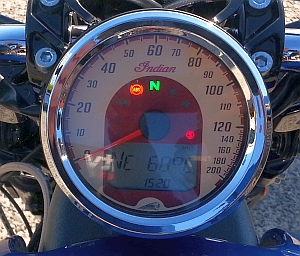
 All the controls are where you’d expect them to be, and fall naturally to hand. The instruments consist of just a speedo, with an engine temperature gauge and a clock. I read after the test that there are other items on display, including a tacho; but at the time I couldn’t see any buttons to push, so assumed that what I saw was all it had. Apparently the button to bring up the other items is on the left switch-block. (Easy if you know!).
All the controls are where you’d expect them to be, and fall naturally to hand. The instruments consist of just a speedo, with an engine temperature gauge and a clock. I read after the test that there are other items on display, including a tacho; but at the time I couldn’t see any buttons to push, so assumed that what I saw was all it had. Apparently the button to bring up the other items is on the left switch-block. (Easy if you know!).
 Speaking of the speedo, it has the numbers spread quite widely apart around the dial. Many speedos – in cars and bikes – are graduated so that a normal fast highway speed has the needle pointing roughly vertical. (That’s a very general rule, but many are different: for example, on my own bike if the needle is vertical you’re in serious go-to-gaol territory!). On this bike, the needle is pointing vertically at 60kph. By the time it gets to 100kph it looks like you’re really fanging it, because the needle is “way around there!”
Speaking of the speedo, it has the numbers spread quite widely apart around the dial. Many speedos – in cars and bikes – are graduated so that a normal fast highway speed has the needle pointing roughly vertical. (That’s a very general rule, but many are different: for example, on my own bike if the needle is vertical you’re in serious go-to-gaol territory!). On this bike, the needle is pointing vertically at 60kph. By the time it gets to 100kph it looks like you’re really fanging it, because the needle is “way around there!”
 As you can see in the photo, the wide spread of numbers continues to 120kph, then it’s as if they suddenly realised they had a lot more numbers to fit in, but not much space to put them; so from there it’s all crammed up close together. From 120kph the next 80kph comes in the about the space as the previous 10kph! You’d get used to this (I got used to it in the relatively short time I had it), but it is a bit odd. And speeds above 120kph are a bit academic I suppose, as you wouldn’t be likely to spend a lot of time cruising at speeds above that.
As you can see in the photo, the wide spread of numbers continues to 120kph, then it’s as if they suddenly realised they had a lot more numbers to fit in, but not much space to put them; so from there it’s all crammed up close together. From 120kph the next 80kph comes in the about the space as the previous 10kph! You’d get used to this (I got used to it in the relatively short time I had it), but it is a bit odd. And speeds above 120kph are a bit academic I suppose, as you wouldn’t be likely to spend a lot of time cruising at speeds above that.
 There is one item that isn’t where you’d expect it to be, and that’s the ignition key. I couldn’t find it! I looked around the speedo area, but it wasn’t there: perhaps down on the frame somewhere (a common place cruisers often inconveniently put it!), but no. I had to ask. Ah, there it is – down on the left, in the middle of one of the chrome side-covers. Again, easy when you know! Not exactly convenient though; and spoils the look of the bike. Then, just in case you get too comfortable with that, the steering lock (I did manage to find that in my search for the ignition!) is a separate lock located down on the steering head.
There is one item that isn’t where you’d expect it to be, and that’s the ignition key. I couldn’t find it! I looked around the speedo area, but it wasn’t there: perhaps down on the frame somewhere (a common place cruisers often inconveniently put it!), but no. I had to ask. Ah, there it is – down on the left, in the middle of one of the chrome side-covers. Again, easy when you know! Not exactly convenient though; and spoils the look of the bike. Then, just in case you get too comfortable with that, the steering lock (I did manage to find that in my search for the ignition!) is a separate lock located down on the steering head.
 Now, while I’m having a whinge, another thing I didn’t like was the side-stand. It’s positioned back a fair way, and hard to reach: you have to stretch your foot back to operate it.
Now, while I’m having a whinge, another thing I didn’t like was the side-stand. It’s positioned back a fair way, and hard to reach: you have to stretch your foot back to operate it.
 Oh yes, and the foot-pegs. They fold, as all do, but they’re not spring-loaded: so if you fold them up, they stay up. This caught me when I started out on the ride. I pulled out into the traffic, put my left foot on the peg but my right foot was prodding the air – I couldn't find the foot-peg. Eventually I looked down and saw it folded up. I kicked it down and all was good. (If you look at the photo below of the engine, you’ll see the peg folded up). Strange; and a bit off-putting when you’re trying to find a peg that isn’t there! They should be spring-loaded.
Oh yes, and the foot-pegs. They fold, as all do, but they’re not spring-loaded: so if you fold them up, they stay up. This caught me when I started out on the ride. I pulled out into the traffic, put my left foot on the peg but my right foot was prodding the air – I couldn't find the foot-peg. Eventually I looked down and saw it folded up. I kicked it down and all was good. (If you look at the photo below of the engine, you’ll see the peg folded up). Strange; and a bit off-putting when you’re trying to find a peg that isn’t there! They should be spring-loaded.
OUT ON THE ROAD
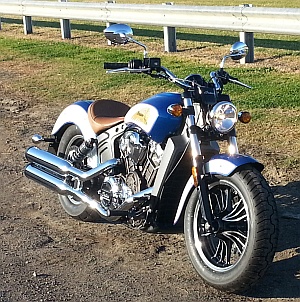
 The test-route I chose involved city running, some highway cruising, and a little bit of back-road. Nothing too challenging, but typical cruiser running. Well, that was the intention, but the start of the ride threw up some unexpected challenges. I turned out of the dealer into horrendous traffic; made worse by roadworks funneling two lanes into one. So it was stop-start (mostly stop!), and crawl. When I was able to, I got out of the mess and took some back streets to get around the worst of it. That involved a few sharp corners and an uphill start on a T-intersection that sloped steeply to the right. So a good test for the maneuverability and rideability of the bike right from the start! And it was in these conditions that the bike started to really impress!
The test-route I chose involved city running, some highway cruising, and a little bit of back-road. Nothing too challenging, but typical cruiser running. Well, that was the intention, but the start of the ride threw up some unexpected challenges. I turned out of the dealer into horrendous traffic; made worse by roadworks funneling two lanes into one. So it was stop-start (mostly stop!), and crawl. When I was able to, I got out of the mess and took some back streets to get around the worst of it. That involved a few sharp corners and an uphill start on a T-intersection that sloped steeply to the right. So a good test for the maneuverability and rideability of the bike right from the start! And it was in these conditions that the bike started to really impress!
 The Scout was superbly easy to ride in the crawling stop-start traffic, handling take-offs from not much more than idle speed with not a hint of stalling. Then turning into side-streets and around 90-degree corners it was surprisingly easy. And when I came to the T-intersection on the uphill sloping road, I felt perfectly confident: no chance of over-balancing or dropping it.
The Scout was superbly easy to ride in the crawling stop-start traffic, handling take-offs from not much more than idle speed with not a hint of stalling. Then turning into side-streets and around 90-degree corners it was surprisingly easy. And when I came to the T-intersection on the uphill sloping road, I felt perfectly confident: no chance of over-balancing or dropping it.
 Of course the low seat height, low centre-of-gravity, and wide bars contribute a lot to that, but it was also testament to the rider-friendly nature of the handling and the engine. I was liking this already!
Of course the low seat height, low centre-of-gravity, and wide bars contribute a lot to that, but it was also testament to the rider-friendly nature of the handling and the engine. I was liking this already!
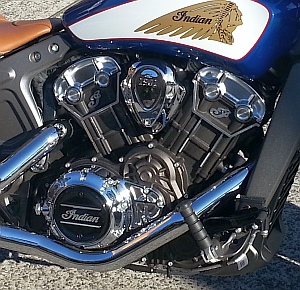
 The engine is a real pearler! At idle there is some vibration but it's well-controlled and not uncomfortable at all. It sounds good too, with that typical V-twin Rumble. It runs smooth, all the way from idle to reasonably high revs. Only after I’d been in the saddle for some time did I begin to feel some tingling in the arms from the vibration; although the vibration, as I've said, was very well controlled: perhaps I was just hanging on tighter than I should have been.
The engine is a real pearler! At idle there is some vibration but it's well-controlled and not uncomfortable at all. It sounds good too, with that typical V-twin Rumble. It runs smooth, all the way from idle to reasonably high revs. Only after I’d been in the saddle for some time did I begin to feel some tingling in the arms from the vibration; although the vibration, as I've said, was very well controlled: perhaps I was just hanging on tighter than I should have been.
 Low down torque is beautiful. On the start of the ride, when crawling along in that traffic, and still getting used to where everything was, as I mentioned above, there was no chance of stalling: it takes off at not much more than idle without any trouble at all. Then when you open the throttle, it responds very well and accelerates quicker than you expect from a small-feeling cruiser.
Low down torque is beautiful. On the start of the ride, when crawling along in that traffic, and still getting used to where everything was, as I mentioned above, there was no chance of stalling: it takes off at not much more than idle without any trouble at all. Then when you open the throttle, it responds very well and accelerates quicker than you expect from a small-feeling cruiser.
 I didn’t know there was a tacho available, so I don't know what revs it was doing; but in top gear it preferred to be up around 70 – 80kph before it felt comfortable. Although, having said that, even at low revs it’s never harsh or shaking; and there’s plenty of power there, even in top gear at low revs on hills.
I didn’t know there was a tacho available, so I don't know what revs it was doing; but in top gear it preferred to be up around 70 – 80kph before it felt comfortable. Although, having said that, even at low revs it’s never harsh or shaking; and there’s plenty of power there, even in top gear at low revs on hills.
 Out on the highway it cruises easily and comfortably at 100 – 110kph.
Out on the highway it cruises easily and comfortably at 100 – 110kph.
 I mentioned that it accelerates quickly, but the impression of just how quickly is exaggerated by the speedo’s widely-spread graduations, as I described above. It does get up and go pretty well, but watching that needle swing madly around the dial makes you think it is really flying!
I mentioned that it accelerates quickly, but the impression of just how quickly is exaggerated by the speedo’s widely-spread graduations, as I described above. It does get up and go pretty well, but watching that needle swing madly around the dial makes you think it is really flying!
 The clutch is smooth to operate, and the gearbox is also smooth. Gear-changes are easy and smooth. Unlike many cruisers, it has 6 speeds in the box too, not 5.
The clutch is smooth to operate, and the gearbox is also smooth. Gear-changes are easy and smooth. Unlike many cruisers, it has 6 speeds in the box too, not 5.
 The handling is excellent! There was no reluctance to turn in, as often happens with cruisers. The front tyre is quite wide, but the back is narrow by cruiser standards and this no doubt helps the responsive handling. I didn't go swinging it through twisties, but around normal corners and even roundabouts it tips in easily and tracks where you want it to go in a manner that is, again, excellent for a cruiser. It’s good at low speed too, and threads its way easily through traffic.
The handling is excellent! There was no reluctance to turn in, as often happens with cruisers. The front tyre is quite wide, but the back is narrow by cruiser standards and this no doubt helps the responsive handling. I didn't go swinging it through twisties, but around normal corners and even roundabouts it tips in easily and tracks where you want it to go in a manner that is, again, excellent for a cruiser. It’s good at low speed too, and threads its way easily through traffic.
 The ride is firm, as cruisers usually are, but doesn't really feel uncomfortable – at least it didn’t on the relatively smooth roads I took it on. Some small bumps were felt a bit, but in normal riding it was more comfortable than I expected. Although there’s not much travel in those rear units, so when the going gets choppy I think you’d really be feeling it. That hard seat doesn't help either! It doesn't feel particularly uncomfortable, but you’re aware that there’s no cushy padding to soften the blows to your butt. On larger bumps I got thrown off the seat a couple of times, which wasn't pleasant and was a reminder that this is, after all, a cruiser with typical cruiser type suspension. It’s just a bit better, in normal riding, than a lot of other cruisers I've ridden.
The ride is firm, as cruisers usually are, but doesn't really feel uncomfortable – at least it didn’t on the relatively smooth roads I took it on. Some small bumps were felt a bit, but in normal riding it was more comfortable than I expected. Although there’s not much travel in those rear units, so when the going gets choppy I think you’d really be feeling it. That hard seat doesn't help either! It doesn't feel particularly uncomfortable, but you’re aware that there’s no cushy padding to soften the blows to your butt. On larger bumps I got thrown off the seat a couple of times, which wasn't pleasant and was a reminder that this is, after all, a cruiser with typical cruiser type suspension. It’s just a bit better, in normal riding, than a lot of other cruisers I've ridden.
 I didn’t make any particular comments, at the time, about the brakes, which means that they are obviously not outstandingly good or bad. I remember them feeling quite adequate without being particularly powerful.
I didn’t make any particular comments, at the time, about the brakes, which means that they are obviously not outstandingly good or bad. I remember them feeling quite adequate without being particularly powerful.
 I enjoyed my time on the Scout! A longer ride may have brought up discomforts in ride and seat that would make me less impressed with the bike, but in my time on it I was very impressed for what it is! The ride is firm, but not as bad as many I've ridden; and the performance really is very good. On some cruisers you feel you’d like more performance, more acceleration, but this had everything you need.
I enjoyed my time on the Scout! A longer ride may have brought up discomforts in ride and seat that would make me less impressed with the bike, but in my time on it I was very impressed for what it is! The ride is firm, but not as bad as many I've ridden; and the performance really is very good. On some cruisers you feel you’d like more performance, more acceleration, but this had everything you need.
 When I got back to the dealer I'd started to feel a little bit uncomfortable from that firm seat and the typical cruiser ergonomics, but it’s a most impressive bike, and certainly one of the best cruisers I've ridden!
When I got back to the dealer I'd started to feel a little bit uncomfortable from that firm seat and the typical cruiser ergonomics, but it’s a most impressive bike, and certainly one of the best cruisers I've ridden!
SNAPSHOT
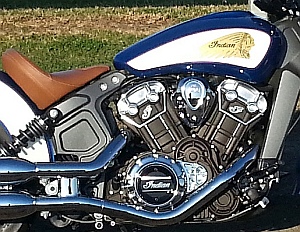
 The Indian Scout really is a good bike. It’s easier to ride than many other cruisers, it has a great engine, good handling, and even a half-decent ride.
The Indian Scout really is a good bike. It’s easier to ride than many other cruisers, it has a great engine, good handling, and even a half-decent ride.
 It’s physically fairly small, although with the forward-controls this lanky old bloke didn’t feel cramped. While the Japanese generally do a good job at making cruisers that are easy and responsive to ride, this is one cruiser that makes buying American a good choice!
It’s physically fairly small, although with the forward-controls this lanky old bloke didn’t feel cramped. While the Japanese generally do a good job at making cruisers that are easy and responsive to ride, this is one cruiser that makes buying American a good choice!
SPECIFICATIONS:
Engine: 2-cylinder, 1133cc. Power: 74.7kW. Torque: 97.7Nm at 5900 rpm.
Gearbox: 6-speed.
Final-drive: Belt
Suspension: Front: Telescopic fork, 120mm travel. Rear: Twin units, 76mm travel.
Fuel capacity: 12.5 litres.
Weight: 244kg (dry).
Seat height: 635mm.
Wheels / Tyres: Front: 130 X 16. Rear: 150 X 16.
Brakes: Front: Single 298mm disc. Rear: Single 298mm disc.
Price: $19,995 +ORC
Ridden: 2017
Click here to go to the front page. Click your BACK button to return to the previous page.
